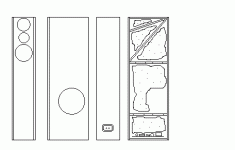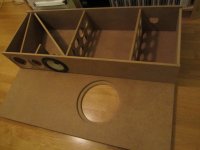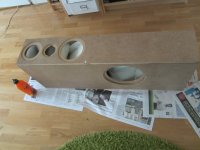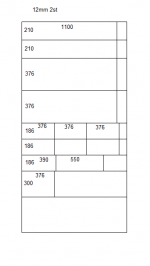I'm a bit sad sombody really didn't like this thread and right away gave it a Terrible rating. 🙁 I didn't know you could do that here. Hope some of you found it interesting or liked it in some way since I noticed not many 4-way designs are built out there. Hope I didn't offend anyone.
This seems like a very knowledgeable and vivid forum. I signed up here to get some info about renovating an old power amplifier and thought I might as well share some experiences I had.
best regards
/Martin
This seems like a very knowledgeable and vivid forum. I signed up here to get some info about renovating an old power amplifier and thought I might as well share some experiences I had.

best regards
/Martin
Don't care about the rating, I assume it's just because the pictures do not appear. 🙂
More important is the speaker. As you say, designing and building a decent 4-way is not a simple task at all. You really can be proud of having done it successfully.
I second the choice of the AL130 as upper midrange because low distortions and plenty of dynamic headroom are very important at this place IMO.
4-way speakers inherently have low intermodulation distortions and the transient response of a sealed woofer is unbeatable anyway. Everything seems very promising. 😀
Congratulations and have fun!
More important is the speaker. As you say, designing and building a decent 4-way is not a simple task at all. You really can be proud of having done it successfully.
I second the choice of the AL130 as upper midrange because low distortions and plenty of dynamic headroom are very important at this place IMO.
4-way speakers inherently have low intermodulation distortions and the transient response of a sealed woofer is unbeatable anyway. Everything seems very promising. 😀
Congratulations and have fun!
Thanks guys! 🙂
Here are some pictures from during the build.
Sketch
Fitting walls together
Glued speaker with damping material inside
2x12mm MDF-sheet cutout drawing
Here are some pictures from during the build.
Sketch
Fitting walls together
Glued speaker with damping material inside
2x12mm MDF-sheet cutout drawing
Attachments
Last edited:
A conventional 3-4" driver is going to be lacking in this respect? Personally I would opt for a driver with more balance with respect to performance at the bass-mid frequencies and the tweeter frequencies. Which isn't to say there is a problem crossing a 5" midrange to 1" waveguide loaded tweeter because there obviously isn't just that there seems to be an opportunity to improve things a small amount.I second the choice of the AL130 as upper midrange because low distortions and plenty of dynamic headroom are very important at this place IMO.
In a ported enclosure twice the size a woofer might extend the bass response an octave lower while matching the transient performance of the sealed woofer at the frequencies above the roll off point of the sealed woofer. Perhaps a fairer comparison is the performance in the octave between the roll off point of the sealed woofer and the roll off point of the ported woofer. Flat with a poorer transient response versus reduced amplitude with a better transient response? There may well be cases where the sealed response is preferable such as appropriate boundary gain but I suspect there are more cases that favour the ported response.and the transient response of a sealed woofer is unbeatable anyway
You've got a point there andy. But IMO, when the deep notes comes with the greater groupdelay, they will sound a little bit like they're not part of the original sound but added. Like the LFE in movie tracks.
I would rather have 30Hz audible but at a lower level than the rest and with the group delay limited, than a sudden shift in groupdelay separating the character of the frequencies.
To avoid the bass from outer space sound lingering in the room separated from the character of other sounds. It is the sharp knee in the response that causes this type of sound.
I would rather have 30Hz audible but at a lower level than the rest and with the group delay limited, than a sudden shift in groupdelay separating the character of the frequencies.
To avoid the bass from outer space sound lingering in the room separated from the character of other sounds. It is the sharp knee in the response that causes this type of sound.
I prefer 4-way but I use all active thus a different mode from what you have chosen. I prefer a 15-18 inch low frequency driver, crossing over to a 9-10 inch mid-bass , into a 3 inch dome and finally a 1 inch dome. I used all Dynaudio drivers except the lowest driver which was a JBL 2235H in a port configuration.
Crossover points 80-100 , 450-600, 4-5 Khz; LR24
I went for a very smooth power response which solves a lot of phase issues. Each driver is in it's own box and physically align the voice coils. Built my crossover at the time based on the article that Linkwitz did and came out pretty good.
Recently I have gotten a DSP crossover and am anxious to tryout the digital delay to further enhance phase response.
Soundstage is very nice and available in many seating locations.
From my perspective I have built many different X-way systems but the current technology seems the 4-way is what you need to cover the dynamic capability and the widest frequency range.
Oh and don't forget to use room treatments.
Crossover points 80-100 , 450-600, 4-5 Khz; LR24
I went for a very smooth power response which solves a lot of phase issues. Each driver is in it's own box and physically align the voice coils. Built my crossover at the time based on the article that Linkwitz did and came out pretty good.
Recently I have gotten a DSP crossover and am anxious to tryout the digital delay to further enhance phase response.
Soundstage is very nice and available in many seating locations.
From my perspective I have built many different X-way systems but the current technology seems the 4-way is what you need to cover the dynamic capability and the widest frequency range.
Oh and don't forget to use room treatments.
Interesting colofan! You don't experience any heat issues in the smaller upper midrange handling a whole decade of the frequency range by itself?
Your setup seems ideal for testing the benifits of aligning the wave front centers. This is as I explained different from time aligning the drivers.
What you do is you use a single tone (usually the intended crossover frequency) and oscilloscope/mic following the phase of the driver around the horisontal plane and marking the maximums on a piece of cardbord oriented horisonally out across from the center of the driver. When you have made a half circle around the front of the driver you have the wave front radius of that circle. Take a rope or something stretched to find the exact point of the wave front center. Should be around or a couple of cm behind the baffle.
Now repeat the same procedure for the other driver. Note the difference and offset the boxes to aligning the wavefronts. Now the phase should sum equally at any point in the horisontal plane in front of the speaker but the min phase accounted time delay might be different so you would have to adress that in the crossover active or passive with a different slope or pure delay.
The point is the drivers will always sum in the way they sum in front of the speaker. No suck out growing in the horisontal off axis response.
If you are up for it. I'd really recommend trying it since you already have the flexibilities needed. Not many designers are even aware this is an issue.
Your setup seems ideal for testing the benifits of aligning the wave front centers. This is as I explained different from time aligning the drivers.
What you do is you use a single tone (usually the intended crossover frequency) and oscilloscope/mic following the phase of the driver around the horisontal plane and marking the maximums on a piece of cardbord oriented horisonally out across from the center of the driver. When you have made a half circle around the front of the driver you have the wave front radius of that circle. Take a rope or something stretched to find the exact point of the wave front center. Should be around or a couple of cm behind the baffle.
Now repeat the same procedure for the other driver. Note the difference and offset the boxes to aligning the wavefronts. Now the phase should sum equally at any point in the horisontal plane in front of the speaker but the min phase accounted time delay might be different so you would have to adress that in the crossover active or passive with a different slope or pure delay.
The point is the drivers will always sum in the way they sum in front of the speaker. No suck out growing in the horisontal off axis response.
If you are up for it. I'd really recommend trying it since you already have the flexibilities needed. Not many designers are even aware this is an issue.
Last edited:
- Status
- Not open for further replies.
- Home
- Loudspeakers
- Multi-Way
- Building a 4-way speaker: some experiences



